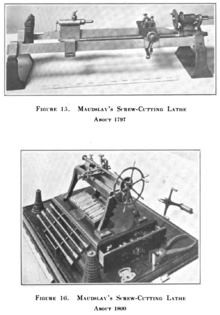Henry Maudslay
Henry Maudslay (born August 22, 1771 in Woolwich near Greenwich ; † February 14, 1831 in Lambeth near London ) was an English machine builder who created the first all-metal lathe with forced guidance of the turning tool via cross support and tool slide and lead screw for machine-controlled tool feed designed for the purpose of reproducibly precise production of motion screws. He is considered the founder of the English machine tool industry. His influence on the machine tool is compared to the influence of James Watt on the steam engine .
Maudslay, son of a wheelwright and naval invalid, was an apprentice at the age of twelve at the Royal Arsenal , the royal arms factory in Woolwich . After a time as a so-called “powder monkey”, as the children used to fill gunpowder were called, he first came to the carpentry shop, then later to the blacksmith for training. Even before the end of the seven-year apprenticeship, word of the young man's extraordinary craftsmanship had got around. In 1789, Maudslay, without completing his apprenticeship, moved to the workshop of the well-known mechanical engineer Joseph Bramah as an unskilled worker. There he quickly rose to the position of foreman. After eight years at Bramah, Maudslay founded his own workshop in London in 1797 . In this he first built his well-known first lead screw lathe with cross support for the mechanical production of the movement screws, which are extremely difficult to manufacture by hand and can hardly be produced with reproducible accuracy. These were of paramount importance for the emerging mechanical engineering, since a simple lathe with cross support, i.e. machine holding and guidance of the turning tool, required three such threaded spindles. The individual technical parts of this Maudslay lathe were already known, among other things, in precision mechanics, but his performance consisted in combining them into a whole according to the higher loads of general mechanical engineering apart from precision mechanics and also without using the previously used and not so to manufacture resilient lathe parts made entirely of metal.
Well-known sales products from the Maudslays company, which initially traded as M. Maudslay Machinist , later called Maudslay, Sons and Field , were a table steam machine and of course the thread cutting lathes, which found huge sales in the then awakening mechanical engineering industry . One of the most important customers from 1808 was the Royal Navy , which also awarded the company its first major order. Based on designs by Marc Isambard Brunel and Samuel Bentham , a set of 45 woodworking machines with an order value of 12,000 pounds was created for the efficient production of pulley blocks for the sailing ships of the Navy. With this set of machines, ten semi-skilled workers were able to produce the same number of pulley blocks as 110 trained craftsmen before. From 1815 there was a specialization in the manufacture of ship steam engines, again mainly for the British Navy.
The Maudslay company can be seen as a multiplier of advanced metalworking technologies at the time; at Maudslay, Richard Roberts , Joseph Clement , James Nasmyth and Joseph Whitworth, among others, worked for a long time before founding their own companies .
His grandson was the diplomat, explorer and archaeologist Alfred Percival Maudslay (1850–1931), who undertook eight expeditions to Maya sites.
Individual evidence
- ^ Günter Spur: On the change in the industrial world through machine tools , p. 146 + 160.
- ^ British Museum website on AP Maudslay, accessed July 24, 2011 (in English) .
literature
- Akoš Paulinyi in: Propylaea History of Technology, Volume 3, Mechanization and Machinization . New edition by Ullstein-Verlag, Berlin 1997, ISBN 3-549-07112-4 , p. 328 ff.
- Wille, Hermann: Great moments of technology , Leipzig 1987
Web links
| personal data | |
|---|---|
| SURNAME | Maudslay, Henry |
| BRIEF DESCRIPTION | English mechanical engineer |
| DATE OF BIRTH | August 22, 1771 |
| PLACE OF BIRTH | Woolwich at Greenwich |
| DATE OF DEATH | February 14, 1831 |
| Place of death | Lambeth near London |

